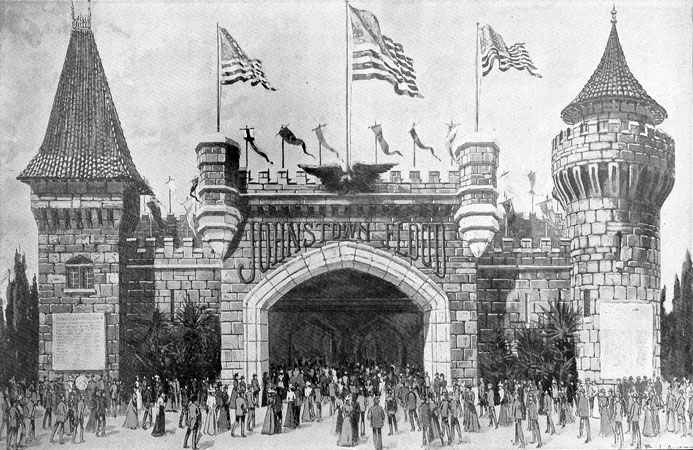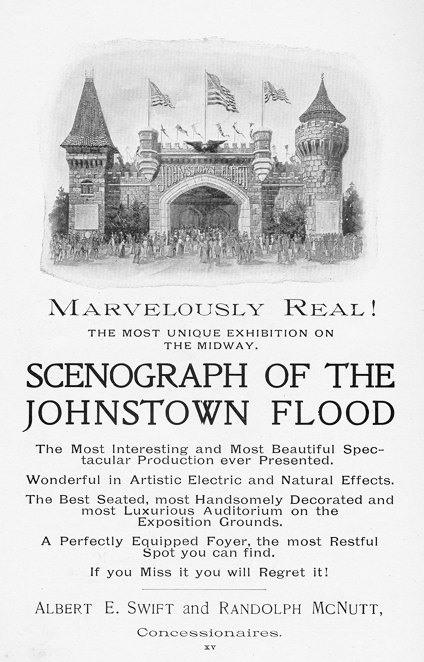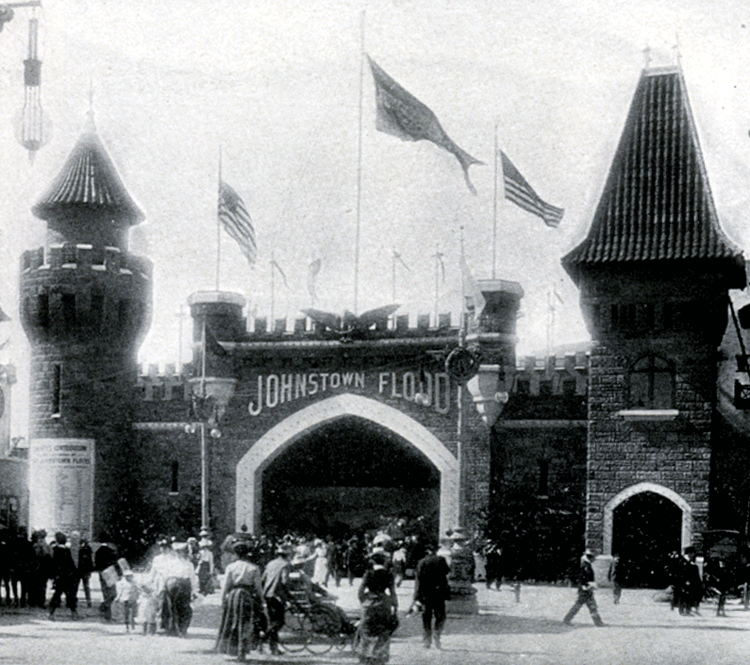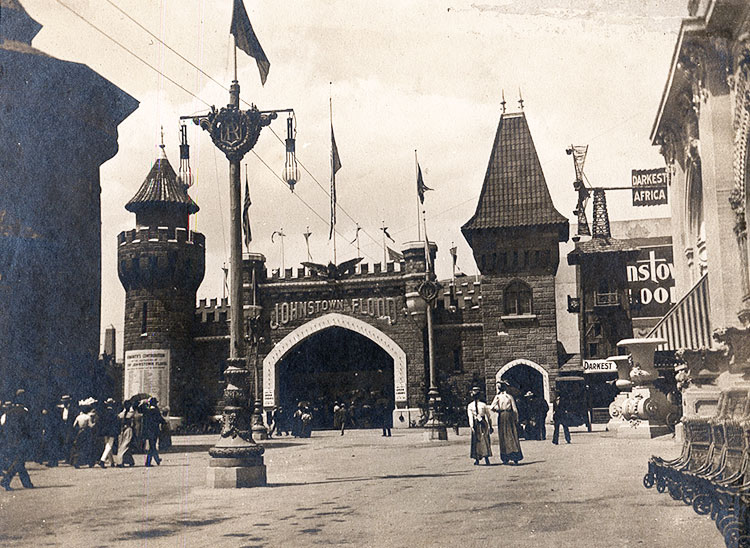|

From the Buffalo Times, May 4, 1901:
"One of the most novel and interesting attractions of the Pan-American Exposition is the scenograph of the Johnstown Flood, by E. J. Austen, artist, Albert E. Swift and Randolph McNutt, concessionaires. The great catastrophe, which cost thousands of lives and horrified the world in 1889, is represented with a wonderfully realistic fidelity. The scenograph combines all the best features of the cyclorama, the diarama and the scenic theater, with the addition of amy unique and novel features which absolutely complete the illusion and give life and movement to the scene.
Mr. Austen is the foremost cycloramic artist of the world, in the opinion of those best qualified to judge. In the preparation of the great scenograph he was assisted by a large staff of noted artists, chief among whom were Charles A. Corwin, Frank C. Pepraud and Herbert V. Brown. In producing the marvelous mechanical effects, E. S. Shea of New York had a prominent part. He is the originator of many devices now being used in the prominent theaters of this and other countries. Herbert A. Bradwell, the electrician, stands at the head of his profession as a producer of novel effects. Many of those in the Johnstown Flood have never been seen before.
The flood is reproduced in the scenograph with details absolutely true to the history of the great calamity and with such striking effect that the beholder is filled with wonder and admiration for the achievement of man's ingenuity, if he can keep in his mind the fact that hte original tragedy is not being enacted before his very eyes.
A story has been prepared for delivery in words which is the exact historical record and a dramatic recital of the awful disaster of the Conemaugh." |

From "Snap Shots on the Midway" guidebook:
"...As a mechanical representation of the phenomena of everyday events, the setting and rising of the sun, the vitreous, pale blue effulgence of the full moon, the thunder and lightning of a terrifying electric storm and, finally, the stupendous burst of water that same over the town of Johnstown with the break of the dam, the show is a spectacle of impressive dignity and life-like appeal. It seems to have struck popular fancy. A scenograph, the logical evolution of the cyclorama, the diorama and the scenic theater, accomplishes the illusion, which is set on an ordinary stage and is in reality a performance in pantomime, where all the actors are what would be called in stage parlance, "properties." Instead of a bit from real life reproduced with fidelity and tinged with poetic fancy, there is shown a black chapter in a sunny history of blithesome, everyday experience, blocked in miniature and, by ingenious mechanism and a skillful use of the values of perspective, brought to startling realism. A mighty tragedy of bold, blunt execution, grand in terrifying energy, involving in fatality an entire populous city, lives again in memory and imaginatin through the medium of a bit of stage craft. [cont'd] |

"The curtain rises on Memorial Day, 1889, more than twenty-four hours before the flood. A Grand Army procession crosses a little bridge, the business of the town is transacted before the spectator's eyes, dusk comes, the lights appear in the windows, trains move across the line of vision, the moon appears, the night wanes and the day of the disaster breaks, rosy and smiling. The hours pass until four in the afternoon, the time when the trickling of the waters from the rivulets that fed the lake of South Fork, fourteen miles away on the mountain side, undermined its half century-old wood foundation and launched the avalanche of water down the Conemaugh valley, sweeping away five thousand inhabitants of Johnstown and furnishing a disaster for which the history of the world has no parallel. An electric storm is made to burst in the stage picture before the arrival of the deluge, when the afternoon of May 31st, 1889, was innocent of water from the skies, but under cover of the darkness and in fitful gleam of vivid lightening the spectacular effect is heightened and is convincing. The cry of the talker: "'The dam is burst!' his relation of the wild ride of Johnny Baker, a ride between flood and a horse, between life and death, the loss of the horse and the death of the noble boy, comes with startling effect. Fire then breaks out in the debris about the stone bridge. Hundreds of dead and other hundreds of living are imprisoned there. They are burned to a crisp. The Catholic church, the field hospital, also breaks into flames. The rescued perish there. Then the fire dies away and the scene darkens. The turn of a hand measures the time of the change coming with the light which shows Johnstown as it is today, rebuilt and flourishing." |

From "The American School Board Journal" June 1901:
Pan-American Headquarters for Teachers
The teachers who will stroll though the Midway of the Pan-American Exposition in Buffalo will find a cosy headquarters designed for their special comfort. The "Johnstown Flood" building has a "Teacher's Headquarters" equipped with easy chairs, writing material and various conveniences. Teachers and school board members may receive their mail addressed care of "Johnstown Flood."
This building is in charge of Mr. Albert E. Swift, who was the local N.E.A. secretary in 1896, when the meeting was held in Buffalo. Associated with him is Mr. Randolph McNutt, the well-known school supply man of Buffalo. The connection of these two gentlemen with the enterprise gives assurance that the scenograph of the Johnstown Flood is well worth seeing and that the courtesies extended at their headquarters to the school people of the United States are an evidence of their generous spirit as well as of their enterprise.
Postscript: New York Times, December 19,1902:
Albert E. Swift, aged fifty-three years. A well-known Buffalo business man and the originator of the 'Johnstown Flood' at the Pan-American Exposition, died suddenly at a Turkish bath at Buffalo early yesterday of heart failure." |
|


